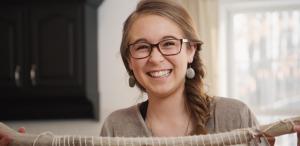No Child Left Inside
In this report, CBN News examines the troubling gap between kids and nature.
Transcript
It's the dog days of summer. If you think your children are out in the backyard climbing trees or riding bikes around the neighborhood, you're probably wrong.
Chances are they're right in your living room chatting online or watching TV. And that's got a growing number of experts worried we might just be raising the first generation of "indoor children."
In this report, CBN News examines the troubling gap between kids and nature.
What's wrong with this picture? A warm summer day in a typical suburban neighborhood. Neighbors are out taking a walk. But why is it so quiet?
Where are all the kids?
"A little boy in a classroom said that 'the reason I prefer playing indoors is because that's where all the electrical outlets are,'" author Richard Louv said.
Louv is author of the New York Times bestselling book, Last Child in the Woods. In it, he details the many dangers of growing up disconnected from nature, a problem Louv calls "nature deficit disorder."
Louv said, "One woman came up to me recently and said that her community had outlawed chalk drawing on the sidewalk. We're raising a generation of children under virtual house arrest."
The National Sporting Goods Association reports that since 1995 the number of children hiking, swimming, and fishing has declined by more than 20 percent. Even bike riding has dropped 31 percent over the past five years.
Dept. of the Interior Secretary Dirk Kempthorne said, "…actually, in some of our national parks, you're seeing a trend that is down."
If you're like many Americans, you'll hit the highways this August. But don't expect the kids to play I-Spy or your other favorite family road-trip games. Who wants to look out the window when you can watch a DVD in the backseat?
But X-Box and IPod's aren't the only culprits. Louv suggests that parents are simply afraid to let their children play outside despite evidence children today are actually safer. Violent crimes against children have dropped more than 38 percent in 30 years.
"Parents, most of all, feel this sense of fear," Louv said. "They're scared to death of stranger-danger. That's, I think, the underbelly of this issue."
What's frightening is the number of children who actually gain weight over the summer months. Nationwide, childhood obesity rates have nearly quintupled among 6- to 11-year-olds and tripled among teens and preschool aged kids 2 to 5 since the 1970s.
Kempthorne said, "We're now seeing Type 2 diabetes, adult onset diabetes, that's occurring now routinely in 6-year-old children."
"Whatever we're doing now is not enough. The greatest increase in child obesity in our history occurred during the same two decades as the greatest increase in organized sports for children in our history. Soccer's great, but it's not doing the trick," Louv said.
A new ad campaign by the U.S. Department of Health and Human Services just may be the trick. Together with DreamWorks Animation, they're urging kids to "Get out and play an hour a day."
It's a start. In fact, there's a nationwide movement underway to "leave no child inside." From hearings on Capitol Hill to legislative programs like the Texas "Life is Better Outside" program, some kids are getting back to nature.
J.T. Maxwell is founder of the Charlottesville, Va.-based GrandClassroom, which has been organizing student field trips to the Grand Canyon for five years.
"This year we brought about 1,500 students from all over the country," Maxwell said. "From all four corners, from as close as Arizona and as far away as Maine."
You can even watch a music video by students from Brookline, Massachusetts on YouTube about their class trip.
Maggie Byrd and Lizzie Dabbs are among a group of 50 rising high school freshman from Richmond, Virginia who just got back from the Grand Canyon.
Maggie said, "At first you think, oh-my-gosh, that's amazing, it's so beautiful. And then you're next thought is, it's so big and like, so perfect. You're almost like, it almost looks fake."
"It was really different out West and it was something that I'd, like, never seen before," Lizzie said, "how it was a lot hotter and a lot drier."
It's the same reaction that 8th grade science teacher Anne Green gets from students every year. This is Green's third trip with her students.
Green said, "I'll ask them, You know, what would you be doing right now? 'Oh I'd be playing this particular game, I'd be instant messaging or IMing or on my cell phone.'"
"I just think it opens their minds so much more than to be in one spot your whole life," Green said, "and on a computer, in a home and not going outside and experiencing nature. It just closes your world."
Whether through environmental education, nature centers, or Scouting organizations, Louv says the key is getting parents involved. Just ask Travis and his mom. They've been involved with the Boy Scouts since first grade.
"It really does a lot for these boys to know that they can do things that they never thought that they could do," Travis' mom said.
"You sit at home, you do nothing, you don't learn nothing," Travis said. "You learn stuff by doing it."
Brett Smiley, a regional director of Boy Scouts, said, "For about 80 percent of the boys that come here, this is their first experience in being outside or swimming in a natural environment. Once they realize that they will be okay after they swim in the lake, it's one more level of confidence that they have about themselves and about the real world."
Which prompts the question, where would these Scouts be if it weren't for places like T. Brady Saunders Boy Scout Camp?
And where will our children be, if recreational habits don't change?
"It would be a sad thing that, as the stewards of America's treasures, we didn't bring along the next generation of the stewards," Kempthorne said.
Louv said, "All of the good things that come to children -- from longer attention span, the stress reduction, the sense of wonder -- all of this come immediately to the adult who takes children into nature, so this is not a bitter pill."
Download
Right-click on a link below and choose "Save link as..." to save the file
High Definition - MP4
High Quality - MP4
Low Bandwidth - MP4





